“Self-contained” certification in New-Zealand
Traveling in New Zealand, that’s good, but doing it on a road trip with your own van, it’s even better. This country welcomes hundreds of thousands of tourists every year, and offers a lot of free parking everywhere for “self-contained” vehicles. It is a good way to travel at low prices, and enjoy some really great places !
As we chose this option, we decided to share with you our tips and tricks to qualify for self-contained certification, at least as we experienced it in 2017. This article doesn’t exempte to visit the official site:
https://www.nzmca.org.nz/certified-self-containment/
Unfortunately, the “self-contained” regulation tends to harden in the years to come, so it is imperative to learn more before embarking on any kind of plannification. Despite all the previous measures we had taken, some rules were not specified on the official website and asked during our passage in front of the “inspector”.
Here is the list of rules as we had to follow, imposed for an autonomy of 3 days:
 Clean water : Clean water: 4L of clean water per person per day. Or, for 2 people, a can with a capacity of 24 liters. We chose to connect our clean water can to a small manual pump faucet, found in a specialized store, for the largest budgets you can find electric pump faucet. Special point not specified on the website, your water inlet pipe must be opaque.
Clean water : Clean water: 4L of clean water per person per day. Or, for 2 people, a can with a capacity of 24 liters. We chose to connect our clean water can to a small manual pump faucet, found in a specialized store, for the largest budgets you can find electric pump faucet. Special point not specified on the website, your water inlet pipe must be opaque.
We used 25L cans, which you can easily find for $ 25 each in any DIY stores, such as Bunnings, or Mitre 10.
We used a piece of garden hose for our water inlet pipe, much cheaper and just as good as an opaque plumbing hose.
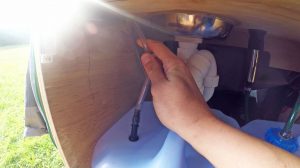 Gray water : Gray water: A can of the same capacity as that of clean water, obviously, all the contaminated water must be able to be recovered. Special point not specified on the website, your gray water supply must be equipped with an air outlet that must lead to the outside of the vehicle, and must pass above the sink level.
Gray water : Gray water: A can of the same capacity as that of clean water, obviously, all the contaminated water must be able to be recovered. Special point not specified on the website, your gray water supply must be equipped with an air outlet that must lead to the outside of the vehicle, and must pass above the sink level.
Your cans must be secure thanks to rigid fixations.
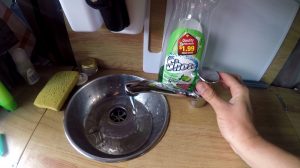 A sink : more convenient to use your water isn’t it ? It must be connected by a siphon to your gray water can, and this connection has to be sealed. For those who wish to be able to move their can of gray water, like us, the difficulty lies in this connection which must be sealed and removable.
A sink : more convenient to use your water isn’t it ? It must be connected by a siphon to your gray water can, and this connection has to be sealed. For those who wish to be able to move their can of gray water, like us, the difficulty lies in this connection which must be sealed and removable.
On the capacity side, there is no obligation, but for your personal comfort, make sure that the depth and width are large enough to be able to do the dishes or to fill a pan of water without difficulty.
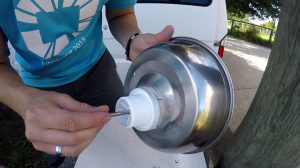
For our sink, given the exorbitant prices practiced, we used a dog bowl (tip found on pvtistes.net), which we cut out to place bung and siphon, and here did the trick.
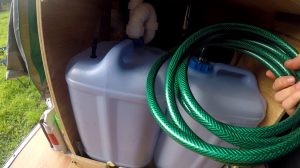 A drain pipe : Your gray water can must be able to be drained without difficulty. To do this, it must be equipped with an opaque drain pipe of minimum 3 meters long that will connect it to a waste water tank. We once again used a garden hose for this purpose.
A drain pipe : Your gray water can must be able to be drained without difficulty. To do this, it must be equipped with an opaque drain pipe of minimum 3 meters long that will connect it to a waste water tank. We once again used a garden hose for this purpose.
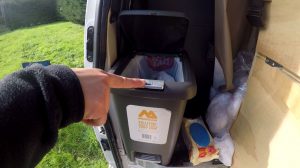 A rubbish bin : it must be equipped with a lid. Special item not specified on the website, your trash must be secured, at least, with an elastic tensioner to not fall during transport. No minimal capacity required.
A rubbish bin : it must be equipped with a lid. Special item not specified on the website, your trash must be secured, at least, with an elastic tensioner to not fall during transport. No minimal capacity required.
 The toilets : with a capacity of 1L per person per day, that is, in our case, a tank of 6 liters. They must be permanently accessible, whether your bed is pulled or not. Special point not specified on the website, your toilets must be secured inside a fixed and resealable box, and those to prevent them from falling and pouring down during transport.
The toilets : with a capacity of 1L per person per day, that is, in our case, a tank of 6 liters. They must be permanently accessible, whether your bed is pulled or not. Special point not specified on the website, your toilets must be secured inside a fixed and resealable box, and those to prevent them from falling and pouring down during transport.
We never used the toilet during our road trip, there are a lot of free pitches equipped with public toilets. In New Zealand public toilets are generally very well maintained.
Once you bring together all of these selection criteria, head to an accredited center in order to pass the inspection. You can find stores specializing in motorhome and mobile home that offers this service for 150 $.
For our part, we had the chance to retrieve the coordinates of a self-containment officer, they are volunteers from the New Zealand Motor Caravan Association, who pass the certification from their home. Normally this information is only available to members of the association, and to be a member it is necessary to count in the 220 $.

Your little vignette in your pocket, you are ready to go on New Zealand roads and all its free parkings ! To makeyour life easier, you can use mobile applications such as Campermate, Rankers, WikiCamps.
You can also find the list of locations on the site of the conservation department : http://www.doc.govt.nz/freedomcamping.
Good luck and have a good trip !

Bonjour je suis en train de finir l’aménagement de mon van et je voulais savoir s’il y avait une taille minimum pour le tuyaux d’air pour le bidon d’eau idée qui va à l’extérieur.
Merci
Felicitations à vous deux pour cet excellent travail, qu’il soit en matière d’aménagement que de communication.
Je suis heureux de découvrir l’une des seules solutions d’aménagement qui sait combiner à la fois un lit généreux (et non découpé), ventilé grâce à son sommier, et une cuisine intérieure accessible depuis les deux portes latérales.
Cependant j’ai deux petites questions;
– la position assise du lit pour manger à la table escamotable est-elle confortable? pour deux personnes la place est-elle suffisante ?
– quant est-il de l’accès à la trappe moteur? peut-on basculer facilement le mécanisme sans avoir à déplacer votre meuble de cuisine ?
Merci encore pour toute l’attention que vous mettez à la transmission de votre expérience.
Sébastien.
Bonjour et merci beaucoup pour tes compliments Sébastien !
En effet nous avons essayé d’optimiser au maximum tout en gardant un confort convenable (malgré la petite taille de notre van)
Pour répondre à tes questions :
– une fois le lit en position assise et la table sortie, nous nous retronvons à bonne hauteur pour manger sans se plier (grâce au toit haut)
une fois le repas terminé un PC sur la table et tu te poses confortablement pour regarder le film 😉
– le meuble cuisine à était découpé et adapté avec les sièges repliés et la trape ouverte, par conséquent aucun problème en cas d’entretien ou de réparation mécanique
Merci encore pour ton super message et à très bientôt !
Super aménagement ! Merci de faire partager !
J’ai une question, nous allons faire le voyage à 4, est-ce que c’est un peu plus galère à aménager en SC ? ça serait juste pour la certification, si on peut se garer au maximum dans les endroits où il y a déjà des toilettes etc, c’est mieux.
c’est pas trop dur la “plomberie” ?
Salut Adeline, merci pour ton commentaire !
Concernant l’amènagement SC, ce n’est pas plus compliqué à 4 par contre il faut multiplier les quantités. A savoir 12L pour l’eau propre et sale pour 1 personne, ce qui représente donc 48L pour 4 (48L pour l’eau propre + 48L pour l’eau sale), bien sur vous pouvez avoir plusieurs bidons reliés.
Idem pour les toilettes : 3L par personne, soit des toilettes avec au moins 12L de capacité (attention, le WC doit être accessible lit déplié).
De notre côté on choisi tout le temps des parkings avec des toilettes, car en effet la théorie c’est bien, mais en pratique personne n’aime aller faire ses besoins dans sa cuisine et sa chambre 😛
Concernant la plomberie tu trouveras notre article détaillé avec en bas de page la vidéo explicative :
http://www.lecoeurelephant.com/etape-4-cuisine-rangements/
Bon aménagement et à bientôt !
Hello! En effet, très utile comme article !
Nous hésitons à acheter un Van SC ou bien juste à le transformer par nous mêmes. Pourrais-tu m’envoyer les photos de l’installation de l’eau ?
Pour ce qui est de la toilette, en quoi consiste le système de fixation?
Encore merci pour tous ces précieux conseils !
Martin
Salut Martin,
Merci beaucoup pour ton commentaire et ta visite.
Si tu tentes la jolie aventure de la construction du van en SC, en plus de l’ensemble de nos articles et vidéos tu trouveras, en suivant le lien ci-dessous, le tutoriel de notre installation d’eau :
https://youtu.be/mSLiMlP7h8k
En bonus, on t’envois des photos par mail 😉
Concernant les toilettes, cela varie en fonction des officers, certains acceptent un simple tendeur élastique, alors que d’autres exigent une boite en bois fixe et refermable.
Bon voyage à toi !
Merci pr tte ces infos. Cest très pratiques. Est ce qu’il y a moyen de m’envoyer plus de photos de l’installation?Merci beaucoup
Merci Suzanne c’est cool de pouvoir aider les autres voyageurs 🙂
pas de soucis on t’envoie ça.
A bientôt
Salut, franchement super aménagement, vous étiez bricoleur avant de commencer le van? vous avez l’air d’être pas mal callé. J’ai plusieurs questions.
1. Quel type de bois utilisez vous? prix?
2. Combien avez vous payé la scie sauteuse?
3. Les mollies dans l’isolation du plafond ça tient le coup?
4. Le système du lit est génial. Vous avez un plan ?
Voilà, je crois que c’est tout. Super boulot les gars.
Salut Martin
Merci pour tes compliments! Nous ne sommes pas des experts en la matière mais on se débrouille 🙂
Alors pour te répondre point par point
1. Nous avons utilisé beaucoup de contre plaqué, c’est pour nous LE bois parfait pour les aménagements, facile à découper et pas très cher
(tout dépend la dimension et l’épaisseur bien sur)
2. Nous n’avons payé aucun outil pour notre aménagement. Comment ? En faisant du Wwoofing pendant 1 mois. Les Kiwis sont très gentils
et généreux, ils nous ont prété volontier leurs outils !
3. Pour les chevilles molly ça tient dans le faux plafond à condition de ne pas trop leur en demander en terme de poid et résistance.
4. Merci, pour le lit nous n’avons pas de plan spécifique, nous avons juste utiliser les dimensions de notre matelas (140/190cm) et
nous avons mesuré la place disponible pour le diviser en 3.
Encore merci pour ta visite et à très bientôt !
Bravo pour votre article, qui permet de répondre à de nombreuses questions 🙂
On souhaite également passer la certification, et nous en sommes au tout début de notre aménagement. Est ce qu’il serait possible d’avoir des photos de votre installation d’eau s’il vous plaît ? C’est une partie qui suscite quelques interrogations de notre part. Merci d’avance
Merci pour ton message Fanny,
concernant la partie cuisine, nous t’envoyons un email avec les photos.
A bientot !
Binjour, tres bonne article. On se pose la question d aménager nous même ou d acheter un van si possible sc ( on ne reste que 3 mous), cela vous a pris combien de temps pour aménager votre van? Merci
Salut Thibaud,
Pour 3 mois on te conseille de prendre un van déjà aménagé.
Pour le notre on a passé 1mois en wwoofing (4 wwoofing pour être précis) pour aménagé entièrement notre van et le certifier.
Merci pour ton commentaire et à bientôt 😉
Salut Salut,
Je viens de lire votre article, très bien ! J’avais déjà vu passer votre blog (on avait je crois échangé sur FB), bon bref ! ^^
Nous nous décidons enfin pour le SC, quelques points encore à préciser, si vous pouvez m’apporter maybe quelques infos…
1 – Est-il possible d’avoir les 24L d’eau propre en 2 ou 3 bidons ? (ex : 2 x 10L + 4 ou 5L)
2 – J’ai entendu dire que maintenant, il fallait être membre de l’asso NZMCA (220$) avant la certification, vrai ? intox ? ^^
3 – Vous êtes directement allé au RV Shop et ils ont tout géré ? Pour combien ?
Merci beaucoup pour vos réponse !!!
Bonne route en NZ !!
Salut Guillaume,
Merci pour ton commentaire, alors point par point :
1 – Honnêtement nous n’en avons aucune idée. (mieux vaut demander aux shops ou encore à l’association).
2 – De ce que nous entendons autour de nous, il est encore possible de passer la certification sans faire partie de l’association,
mais cela tend à changer à très court terme, aussi certains shops obligent déjà l’enregistrement.
3 – Nous sommes allés au RV shop de Tauranga dans un premier temps pour checker notre installation et voir si des éléments manquaient.
Après avoir répondu aux critères manquants ils n’ont, malgré tout, pas voulu nous certifier. C’est à partir de là que nous nous sommes tournés
vers un SC officer de l’association sur Tauranga (Malheureusement nous avons appris qu’à aujourd’hui l’un comme l’autre demandent explicitement de faire partie de l’association).
A bientôt et bonne chance.
Merci beaucoup pour votre réponse, je vais me renseigner plus en détail sur le fait d’être membre de l’asso, il y a quelques avantages (remise VTNZ, remise ferry, remise sur certains campings, à voir…
Merci et à bientôt
Hello,
Super votre aménagement !! C’est une Nissan canette que vous avez ? J’ai quelques questions à vous poser car je compte aménager mon van aussi. Notamment au niveau des toilettes, où est-ce que vous les avez mis? Et qu’elle est la longueur de votre lit?
J’espère que votre trip en NZ se passe bien !!
Camille
Merci Camille !
En effet c’est un Nissan “Vanette” que l’on possède (modèle high roof).
Au niveau des toilettes, on l’a placé à droite de notre cuisine pour pouvoir y accéder lit déplié (bien sur ce n’était que pour la certification)
on ne l’utilise pas et privilégions les parkings avec toilettes (en Nouvelle Zélande il y a en beaucoup et propre)
Concernant la longueur du lit dépliable, c’est un taille double (190 / 140cm) parfait pour rentrer à 2
et pour le plier en mode sofa car le matelas est en mousse.
Bon aménagement et à bientôt !
Bonjour a vous,
Super travail, ca me motive à préparer mon van par moi même!
Pourriez vous me faire passer des photos de l’installation svp :).
Merci!!
Merci Martin !
Nous t’envoyons un email avec les photos.
A bientôt
Woaw super article ! Il y a la réponse à toutes les questions que je me posais. On réfléchit pour faire notre van self contained également!
Est-il possible d’avoir quelques photos en plus pour voir le détail de votre installation SVP? (les raccords tuyaux d’évacuation/bidon d’eau grise, le tuyau d’aération qui passe par la trappe de la batterie etc…)
Du coup je vais visiter le reste de votre blog et faire le plein de tips pour notre voyage ! Yaaaah ! 🙂
Merci beaucoup Thibault, c’est avec grand plaisir que l’on partage notre expérience et cette fameuse certification.
Aucun problème nous t’envoyons aujourd’hui les photos.
Bonne visite sur notre blog et à très vite.
Hello et merci pour votre article ! on va s’aventurer à transformer notre van dans les prochains jours, et on commence tout juste à faire des plans. On se trouve aussi près de Tauranga, du coup vu que l’inspecteur que vous avez eu avait l’air très pointilleux, on a peur d’avoir droit au même genre de réclamations.
Comment aviez-vous fait passer le tuyau vers l’extérieur (pour les eaux sales) ? Comment aviez-vous pensé la connexion amovible et étanche du bidon eau propre ? Pouvez-vous aussi m’envoyer plus de photos en mail ? MERCI mille fois !!
Merci Coralie pour ton commentaire. Sur Tauranga, la personne pointilleuse ce trouve à RV shop :
– pour faire sortir le tuyau hors de l’habitacle nous avons utilisé la trappe de la batterie.
– pour le bidon d’eau propre nous avons utilisé un embout de jardinage.
Nous t’envoyons un email avec toutes les photos
Merci encore pour ton commentaire ça nous fait très plaisir.
Super article, ça m’a bien aidé pour bricoler mon van! Un seul point n’est pas claire, pourquoi faut-il “’une sortie d’air qui doit conduire à l’extérieur du véhicule, et doit passer au-dessus du niveau de l’évier.” pour le bidon d’eau grise ? C’est vrai que sur le site il dise un bidon d’eau grise”vented” (aéré) mais je vois pas bien ce qu’il faut faire et surtout pourquoi au dessus du niveau de l’évier ?
Merci pour la réponse.
Merci Norman pour ton commentaire, en effet nous avons pris conseil auprès d’un shop officer puis nous avons passé notre certification chez un self contained officer et les 2 (sur Tauranga) nous ont dit de :
-faire passer le tuyau par dessus l’évier avant de redescendre (on n’a pas vraiment d’explications là-dessus)
-de faire sortir le tuyau hors de l’habitacle (pour ne pas avoir les gaz “nocifs” à l’intérieur)
Cependant d’autres personnes on eu des officers plus “soft” et pas de problèmes.
Nous avons joué la carte de la sécurité et réalisé ça (c’est plutôt facile, et nous t’envoyons un email avec photos).
Merci encore pour ton commentaire ça nous fait très plaisir.
A bientôt
super super cet article !! Je prends note de tout, mais punaise je m’y retrouve pas trop, sur la photo je vois pas bien comment vous avez fait.. Pour l’eau propre.. Je m’y perd un peu jai limpression que cest complxe !Ce serait possible que tu mettes une photo d’un peu plus pres ?? En tout cas merci pour tout jadore !
Bonjour lilou et merci pour ton commentaire! Concernant le tuyau d’eau propre, c’est très simple, il te suffit de mettre un tuyau qui va jusqu’au fond du bidon et faire un trou dans le bouchon du bidon pour le faire passer et le fixer à ta pompe manuel.
nous t’envoyons par mail des photos.
A bientôt,
le coeur éléphant